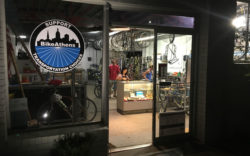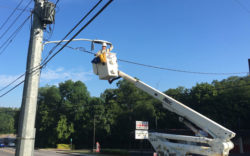Which sounds worse to you: carrying your groceries out in a disposable plastic shopping bag or buying coffee in a paper to-go cup with the cardboard sleeve and plastic lid? I suspect there are a number of people in Athens who wouldn’t be caught dead without their reusable shopping bags but are happy to walk around sipping joe from a disposable cup because they put the cup, lid and sleeve in the recycling bin.
Here’s a hard, simple fact: Whether that paper cup is blazing orange or white with a green dot, neither the cup nor the lid are accepted at our recycling facility, and the ones that are sent there must be hand-sorted out and sent to the landfill instead. The sleeve is recyclable, but my sources at ACC Solid Waste tell me that they’re small enough that they often filter out with the rest of the contaminants that go to the landfill. All of this is quite expensive and is an increasing concern for the county recycling folks.
Paper coffee cups are very difficult to recycle—or compost, for that matter—because they have a polyethylene lining that is permanently bonded to the paper. Without it you’d literally have a hot mess on your hands. (Cold drink cups, also not recyclable, are usually coated with wax inside and out to protect the paper from the contained drink as well as condensation on the outside.)
Coffee cup lids are polystyrene (No. 6 plastic), the rigid, unfluffy version of what we usually call Styrofoam. As a low-temperature thermoplastic, the stuff is technically easy to recycle, but two main factors prevent polystyrene food containers’ wide acceptance in recycling streams. One is that it is porous, so it gets contaminated as it absorbs food and drink residues. The second is that it is ridiculously cheap to make. Styrene is a byproduct of gasoline refining, and it’s so inexpensive to produce that there is no economically competitive way to collect and recycle polystyrene food containers by comparison.
Years ago Starbucks made a push to develop a “sustainable” disposable cup by 2015, but a year after that fruitless deadline their company line is to encourage customers to bring in reusable drink containers instead (preferably purchased at Starbucks). About 2 percent of their global customers do so. Many cafes, including Starbucks and our own Jittery Joe’s, offer a nominal discount (about the cost of a disposable cup and lid) for those who bring their own, but clearly this doesn’t overcome the lure of throwaway convenience for most people.
How much better are reusable cups than disposable ones? In my Jan. 6 column I wrote about embodied energy and life cycle assessment (LCA). Just for fun, I ran some calculations to compare the embodied energy of my favorite insulated, stainless steel coffee flask against an equal sized paper cup with a lid and sleeve. I would need to use the flask about 14 times to break even with the embodied energy of the paper cup and its accessories, including hot water for washing. (Incidentally, a paper coffee cup has the same embodied energy as 13 plastic shopping bags.) I’ve used it daily for at least five years, so I’m in the black, as it were, and I have the added benefit of a product that I can chuck into the scrap metal at the CHaRM (Center for Hard to Recycle Materials) when it ultimately wears out.
Cool Deal: Remember way back on Aug. 19 when I talked about electric rate plans like the Georgia Power Smart Usage Rate? If you can curb your usage from 2–7 p.m. on summer weekdays and always avoid running multiple pieces of equipment together (e.g. the dishwasher and the clothes dryer), then you will likely be able to reduce your annual electricity costs if you switch to that rate. Now Georgia Power is offering a free Nest thermostat ($249 value) to anyone who switches. Chez Greensplainer has a Nest, and in my experience it saves heating and cooling energy above and beyond a more typical programmable thermostat. I’d jump at this deal. Contact Georgia Power to learn more.
Like what you just read? Support Flagpole by making a donation today. Every dollar you give helps fund our ongoing mission to provide Athens with quality, independent journalism.










